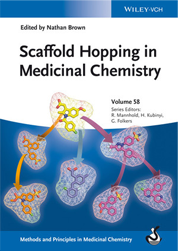Improving PROTAC properties via single-point changes to linkers
We explore how computational methods can be applied to proteolysis targeting chimera (PROTAC) design, to effectively tackle some of the ...
News

This book is part of the series ‘methods and principles in medicinal chemistry’.
The first section serves as an introduction to the topic by describing the concept of scaffolds, their discovery, diversity and representation, and their importance for finding new chemical entities. The following parts contain a general description as well as case studies of the most common tools and methods for scaffold hopping, whether topological, shape-based or structure-based. Part two, chapter 13 explores Cresset’s ‘XED force field and Spark‘ and was co-authored by Dr Andy Vinter and Dr Martin Slater. The final part contains three fully documented real-world examples of successful drug development projects by scaffold hopping that illustrate the benefits of the approach for medicinal chemistry.
While most of the case studies are taken from medicinal chemistry, both chemical and structural biologists will also benefit greatly from the insights presented here.
Case study 2 ‘Bioisosteric Replacements for the Neurokinin 1 receptor (NK1R)’ by Francesca Perruccio (pages 259-278) cites Spark, Cresset’s dedicated scaffold hopping too.
Now available as an eBook from various online vendors, the book is scheduled for physical publication in December 2013.
Nathan Brown is the Head of the In Silico Medicinal Chemistry group in the Cancer Research UK Cancer Therapeutics Unit at the Institute of Cancer Research in London (UK). At the ICR, Dr. Brown and his group support the entire drug discovery portfolio together with developing new computational methodologies to enhance the drug design work. Nathan Brown conducted his doctoral research in Sheffield with Professor Peter Willett focusing on evolutionary algorithms and graph theory applied to challenges in chemoinformatics.
After a two-year Marie Curie Fellowship in Amsterdam in collaboration with Professor Johann Gasteiger in Erlangen, he joined the Novartis Institutes for BioMedical Research in Basel for a three year Presidential Fellowship in Basel working with Professors Peter Willett and Karl-Heinz Altmann.
His work has led to the pioneering work on mulitobjective design in addition to a variety of discoveries and method development in bioisosteric identification and replacement, scaffold hopping, molecular descriptors and statistical modeling. Nathan continues to pursue his research in all aspects of medicinal chemistry.